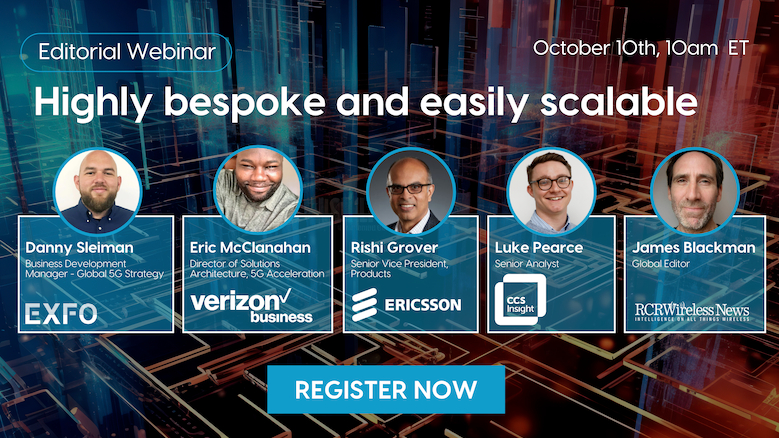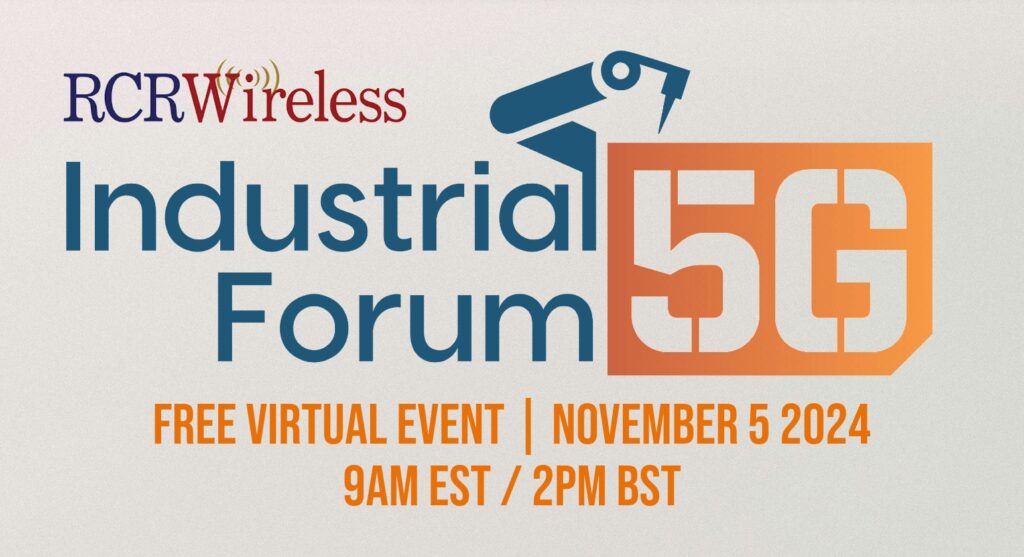Sign up here to join the RCR Wireless webinar on how to scale private 5G in Industry 4.0 (‘balancing customisation and simplicity in private industrial 5G networks’) on October 10 2024, featuring speakers from CCS Insight, Ericsson, EXFO, and Verizon Business. Also, look out for the new editorial report on the same subject, out next week, featuring Kyndryl, plus a cross section of the Industry 4.0 community. Sign up here to join Industrial 5G Forum, a one-day virtual event, on November 5 2024.
A replay, here, of a conversation with US integrator Kyndryl about private 5G in Industry 4.0, which quickly gets into the head-banging cultural conflict that can arise between IT and OT departments in mega-sized industrial firms when they sign off on big private 5G projects. Because forget all the trouble with network management, access control, application development, device availability; these can be mostly explained and engineered, albeit at some length. The real challenge is to bang IT/OT heads together – so both sides of the house are happy. And sometimes, there is nothing even a diplomatic Industry 4.0 consultancy can do.
It is interesting because this story never gets told. Discussion about how to scale 5G systems tends to be at arm’s length from the coal-face harrying required to actually make them work; and enterprises, which rarely talk about it anyway, will never admit to internal strife as a blocker for well-engineered infrastructure projects. But Kyndryl is unafraid. Chris McReynolds, the firm’s vice president of edge compute and networks, blows out his cheeks and chuckles, a little; he’s seen the hype outrun the reality with every Industry 4.0 miracle-cure in the last 20 years, and has watched, a little helplessly, as enterprises repeatedly shoot themselves in the foot.
The exchange goes like this. Has this gone as fast as Kyndryl had hoped, or expected? Because it seems like private 5G has ‘legs’, but it is clearly trailing behind the hype – whether because of complications with the technology, or inertia within enterprises. He responds: “Yeah, but I’ve seen the hype so many times. So I’m not surprised at all. Would we like it to move faster? Absolutely. But there is always a ‘new thing’, and always hurdles with it – with spectrum, with devices, with the technology itself. Sometimes with all of it. And then you go to enterprises, and there are a whole bunch of cultural and financial challenges as well.”

He goes on: “So, you’ve got a new technology that kind of works, but how much better is it, and does it justify the money? And then in manufacturing, say – where private 5G makes most sense – you come up against these structural issues. IT might have a mandate to deploy this stuff across lots of factories, but each one is like a little [OT] fiefdom. Each plant is a snowflake. They’re not all the same; each one is controlled by a plant manager with their own productivity objectives; responsible for worker safety and for producing whatever widgets they’re producing. So there is conflict, sometimes. Driving IT standardisation across all of it [is not always easy].”
Of course it is not; internal conflict is the central challenge for change management, every time. Sometimes it just needs saying; and McReynolds effectively moves the Industry 4.0 narrative beyond the kind of tech-centric navel gazing that tends to derail it. It’s funny, says RCR, because others have said that IT/OT collaboration is smoother now, over the last 12-18 months – that the OT side is being properly engaged to scope the enterprise solution and the business case, in order for the IT side to approve the budget and scale the project in a joined-up fashion. But you’re saying that is where it comes unstuck?
Is it more common in entrenched blue-collar sectors, maybe? “It probably depends more on the customer [than the sector]. Sometimes it goes very smoothly,” responds McReynolds. “But, yes, the gestation is with the OT side. The problem is sometimes that IT sees the success [in a single plant], and steps in to replicate it everywhere. That’s when conflict arises. The plant manager was on board in that first facility – which is why the project was a success. But it won’t necessarily work as a centrally imposed corporate IT initiative if you don’t have buy-in from OT staff in every other facility.”
So it is like a classic power play – where one side, down on the floor, won’t be dictated to by the other, upstairs in the office? Because they feel cornered – because their work and targets will change? ”Yeah, that sums it up well,” says McReynolds. At once, the picture magnifies this extant challenge to deploy bespoke solutions in bespoke environments – because they are governed by bespoke cultures. At the same time, it shows – rather like the odd couple that argue about ideas until the ideas are presented as their own – that digital change requires cultural change (of course!), which must be pursued in a phased collaborative fashion.
The same goes for private 5G, then, as an operational technology in fragmented industrial environments. How are private 5G sales for Kyndry, actually? “Good, yeah; they continue to grow. We continue to expand with new customers and existing customers – to new locations. The markets that are buying this stuff are still pretty consistent – a lot of oil and gas, industrial, manufacturing; good traction in federal (defence), as well. But it’s not like it’s branching out to, you know, 50 different verticals. It is relatively concentrated, and really about big indoor spaces, or big indoor-outdoor spaces. Which is where you really get the coverage benefit versus Wi-Fi.”
Is the neutral-host proposition not opening up more hardwood / carpeted types of venues, potentially? McReynolds responds: “Yeah, we see some of that – in hospitality, healthcare, big box retail; places where you start with better coverage for devices on the public network. And then, because you’re deploying the same equipment, it sometimes works as a stepping stone to a private network – in locations where it’s harder to justify its business benefit out of the gate.” And, despite a lack of joined-up IT/OT thinking sometimes, is the view correct that private 5G deals with enterprises are more rapidly multiplying across larger footprints?
McReynolds says: “Yes, absolutely. I can’t think of a customer that was ‘won/one-and-done’ – which said, ‘yeah, interesting, we tried it; it didn’t work’. You start small, for sure, but it grows quickly to multiple facilities – and then, yes, the faster it cascades, the more it sometimes runs into [internal conflict].” So back to this IT/OT breakdown: the issue is not just about power structures within big enterprises. For private 5G to scale in industry 4.0, the task for solution vendors is to make generic systems for “snowflake” deployments, as far as possible, and the task for integrators is to make bespoke “snowflake” systems out of these generic ones.
Which is the whole discipline for an integrator like Kyndryl, right? McReynolds says: “There are a decent number of companies that can deploy a wireless network to cover a site, and do it well. And there are a decent number that can handle the device management. But very quickly, you get into digitising factory workflows and processes, and building integrated solutions – so you can put workloads onto these networks, and so you enable collaboration and secure access for visiting contractors. And all of that is the system integration piece, which is more than telcos can do.” The point about digitising processes is another reality check, of course.
Does Kyndryl roll its eyes, to an extent, at all of this talk about generative AI? Not because it’s not good or exciting, or even viable, but because there is enough complex work (and hard diplomacy) at the coal-face of Industry 4.0 just to digitise physical assets to make industrial workloads available to such networks and applications? “Yeah, I agree, one hundred percent. There is so much benefit in just connecting workers to make everyday tasks simpler,” he says, making reference to a client that has “quantified five-times FTE reduction” (which “adds up per facility”, apparently) simply by digitising a set of unspecified processes.
The detail is not clear, but the message is; McReynolds says there are clear operational gains, as well, in terms of predictive maintenance and worker safety, but also in terms of imposing a common structure on “crazy old protocols” in order to ingest and analyse factory data. “And then there is security,” he says. “If you’re going to do anything that bridges that kind of OT island-world into a broader IT world, then your plant managers are going to need a lot of comfort and confidence. So IT/OT security is the other piece. And until all that stuff’s in place, you don’t get to do the cool futuristic stuff (like generative AI).”
Point taken; it shows how far removed most of the discussion about private 5G and industrial AI is from the daily grind of Industry 4.0. To the extent it makes one think whether the reality – for a business like yours, engaged with clients about their day-to-day digital transformations – is that the prospect of a big global enterprise that can go root-and-ranch to upgrade its processes, networks, and applications is a unicorn concept? Because it doesn’t exist; and all this chat about easy scalability of private 5G is anathema to this reality. McReynolds laughs. “It’s hard,” he responds, and tells about a client that has cleared the decks to make the leap.
He says: “[This customer] has a very pragmatic short-term view and also a very long-term strategy. We have spent lots of time together building-out a plant service-bus to connect all these different devices and sensors, and to translate all the protocols in a single platform, and secure their data so only certain of it goes to the public cloud. But the solution is consistent – because the protocols, while old and scattered, are known. And they want to translate this platform to all of their different facilities – which may be snowflakes, but have a common platform, now, with the same aggregation and security stance, to drive custom insights for each factory.”
Somewhere in there is an answer, probably; whatever, in the interests of space and time, the conversation has to end.
Sign up here to join the RCR Wireless webinar on how to scale private 5G in Industry 4.0 (‘balancing customisation and simplicity in private industrial 5G networks’) on October 10 2024, featuring speakers from CCS Insight, Ericsson, EXFO, and Verizon Business. Also, look out for the new editorial report on the same subject, out next week, featuring Kyndryl, plus a cross section of the Industry 4.0 community. Sign up here to join Industrial 5G Forum, a one-day virtual event, on November 5 2024.



